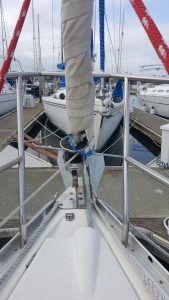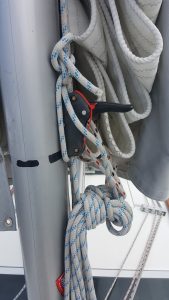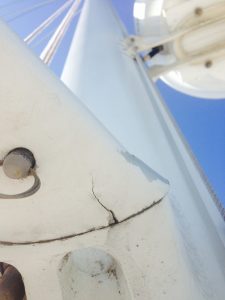No, I’m not mad at you and making you get off the boat at some distant port where you must walk home. It’s me that I am talking about. It’s the skipper that must get off the boat. Never cast-off dock lines without the person responsible for the safety of the vessel and crew getting off the boat and taking a walk around the vessel while making a final check of SAFETOGO and COOL items. Especially, the Onboard rigging, Coolant, and Overboard Lines portions of the checkout process.
For a refresher of SAFETOGO:
- Safety Equipment
- Atmospheric Conditions
- Floorboards
- Engine
- Tides and Currents
- Onboard Rigging
- “Gas” or Diesel
- Steering
And Cool:
- Coolant
- Oil
- Overboard Lines
Before starting the saltwater motor from What is 180, all items of SAFETOGO and COOL must be checked off. Unfortunately, too often that’s the end of the safety check process. It shouldn’t be!
Immediately after starting the motor, go back and do a more complete check of the onboard rigging, coolant, and overboard line situation. The best way to do that is to get off the boat and do a walk around.
Start wherever the exhaust from the motor exits the boat. Then, make as complete a circle around the boat as the docks allow, checking every aspect of the boat from stern to stem, and from waterline to the top of the mast. Follow an organized process … better yet … develop a checklist for yourself to follow.
For example:
- Exhaust – is there sufficient coolant exiting the exhaust to indicate proper cooling of the motor is taking place?
- Transom – is/are there signs of damage? Backstay properly attached?
- Stern Pulpit – Damaged? Sturdy? “Legs” properly fastened? Lifelines properly attached?
- Backstay – Move your eyes the entire length of the backstay, pausing regularly for a few seconds to let your brain catch up and interpret what your eyes a seeing. Yes, there is a difference between looking and seeing. It’s your brain.
- Mast head backstay connection – use binoculars if it helps.
- Mast head instruments – in place and working properly? You might even have someone check the electronic readouts on any mast head instruments to make sure they are working.
So far, you have not even moved from the original starting point. Now, start moving slowly forward, checking things as you go.
- Hull?
- Toe rail?
- Stanchions?
- Lifelines?
- Are there any lines in the water?
- Chain plates?
- Turnbuckles?
- Wire?
- Spreaders – (this one check should be slow and complete) Proper horizontal angles? The same on both sides? Shrouds over the tips? Properly attached to the mast? Visible cracks? Anything that just “doesn’t look right”?
- Below spreader attachments?
- Mast head attachments?
Continue forward looking at the hull, toe rail, stanchions, and lifelines, and lines in the water:
- Bow pulpit?
- Bow roller?
 Anchor?
Anchor?
At the forestay:
- Deck attachment?
- Furling drum?
- Jib tack – is it properly attached and positioned in relation to the furling system?
- Jib sheets – properly attached to the clew with two wraps around the furled sail? Properly routed along the deck, through fairleads, and back to the jib sheet winches?
- Jib halyard properly tensioned (DO NOT change the jib tension … if a problem is noticed, notify the office and we will correct it).
Start moving aft repeating the process on the other side (in reverse). When you arrive back at the transom:
- Topping lift – in place? Damaged? Functioning properly?
- Visually check the main halyard – Properly attached to the head of the sail? Properly routed to the top of the mast? Wrapped around or through anything (topping lift, lazy jacks)

By now, your eyes should have traveled to the top of the mast at least twice. Each time, follow the mast back down and check everything (e.g. are all clutches on the mast closed).
At some point during the walk around, you will pass the shore power connection. Is it disconnected and secured on the dock (or, removed from the dock and stowed aboard if you are going to dock overnight somewhere with shore power)?
How about dock lines. As you move around the vessel, check what lines are in place, and which might be safely removed as you go. For example, can the springs be removed and placed safely on the dock? I personally make sure any line long enough, and positioned in a place that it can reach the propeller, has been removed and placed securely on the dock. I do not want it to fall in the water while casting off.
In closing, as a captain, it is critical that before casting off lines and departing, you personally have done everything in your power to verify the safety of your vessel! The lives of yourself and your crew may depend on it.


I learned to explicitly include:
* to ease all sheets, turn all the blocks by hand, and check if the traveler runs smoothly. A winch does grind a dry bearing to dust with surprisingly little effort …
* to check the safety pins/rings on the shackles, in particular the flimsy ones at the lifelines. Those bend easily and then its only a matter of chance for the bolt to drop.